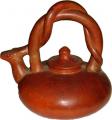Gong-fu Cha is a specific method of preparing tea. Gong-fu Cha originates from China and is mainly used to prepare oolong tea. The method may also be used for black tea, but is considered inappropriate for green teas.
Gong-fu Cha is also known as the Fujian tea ceremony, as it originates from the Fujian province of China, but unlike other tea ceremonies (such as Japanese and Korean), the tea is the showcase. The steps of the ceremony are designed to extract the best possible flavor of the tea.
Equipment used in Gong-fu Cha
There are four essential components of Gong-fu Cha:
- Tea pots: The teapots used in Gong-fu Cha should ideally be made from unglazed yixing clay. Yixing clay is known for producing teapots that can improve the taste, texture and aroma of tea.
Yixing clay has the effect of melding flavors from previous brews into the current brew, as holes in the clay can trap oil from the tea. The clay can also maintain an even, high temperature for long periods of time.
The pot should be small, in order to control the temperature time.
There are usually three pots that are used: one for boiling the water (largest), one for brewing and one for serving (smallest). - Tea cups: Tea cups used in Gong-fu Cha are generally small. It is designed so that tea is finished within one or two gulps.
- Water: Water used for Gong-fu Cha should be just boiled. It should not be distilled as this can result in a flat-tasting tea. Fresh spring water is the most preferred type of water.
Water is used to warm the implements and wash the tea, as well as brew the tea. - Drip tray: The tray is used to contain spilled water, as plenty of water is used in Gong-fu Cha.
Procedure of Gong-fu Cha
Gong-fu Cha requires a suitable space. The procedure requires a table large enough to hold the utensils required. Ideally the surroundings are peaceful and relaxing. Usually, this is created through the use of incense, flowers, soft music and songbirds.
To begin Gong-fu Cha, water is first brought to boil, and then placed onto a smaller stove to maintain the temperature. The brewing pot is filled to the brim with water and its lid replaced. Water is then poured around the outside of the pot, to quicken the heating process.
The water is then poured into the serving pot and into the cups, to warm the utensils and also to wash away any dust.
The tea is measured and placed into the brewing pot, which is then filled with water again. The water is quickly poured out again as the above process is repeated. This is to wash the tea of unpleasant flavors.
After the washing is done, the first round of brewing commences. The brewing pot is again filled to the brim with water. Excess foam and tea leaves are swept aside using the lid before the lid is replaced and hot water is poured over the top of the pot.
The tea is allowed to brew for about a minute before being transferred to the serving pot.
The tea is then consumed, usually lightly using small sips.
Subsequent brewing follows the same procedure. Quality Oolong tea can be brewed 5-6 times, with the second and third brews traditionally acknowledged as the best.
